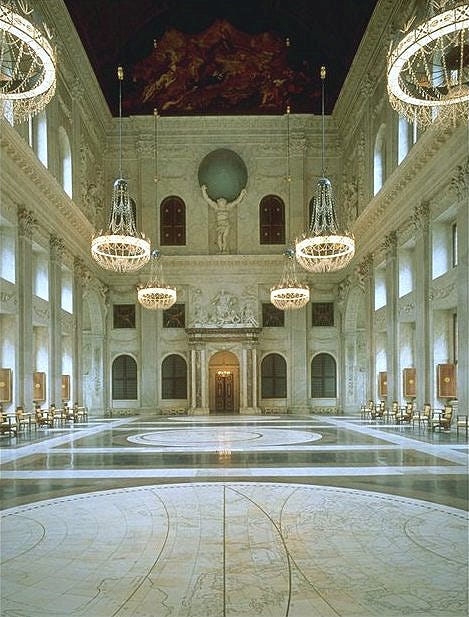The Wisselbank, the Bank of Amsterdam
How the Eurozone might be at the dawn of a monetary Golden Age
If there is something that teaches modesty it is looking for physical traces of the history of finance. Masters of the universe might shape the world in their lifetimes, becoming fantastically wealthy, and yet leave no trace beyond some faded ledgers.
Case in point is the Bank of Amsterdam (Wiki), known in Dutch as the Wisselbank (Wiki). It has claim to being the world’s first central bank, tasked with stabilizing and standardizing the value of the guilder current in the Dutch Republic. It was hardly what we’d recognize as a bank: it gave no credit and paid no interest on deposits. What it did was accept gold and silver coins in exchange for ledger entries1 which subsequently became the international unit of account of early modern Europe—because they were so much more convenient for trade than the plethora of coins (more than 500 kinds) in circulation at the time.
Once housed in the Stadhuis (now Paleis) op de Dam, it would open between 11am and noon so merchants who had traded at the Beurs that morning could settle their accounts and go to the tavern for the rest of the afternoon2. Among those merchants were kassiers, who traded foreign currency as well as promissory bank notes—claims on the bank’s accounts—to avoid the transaction costs involved with editing the bank’s central ledger: the Grootboek.
Why am I boring you with the details of a two-centuries-defunct bank3? Firstly, because I am still miffed that after three expeditions to Amsterdam I have yet to find any museum mentioning it—even DNB’s exhibit on money begins at its own founding after the Wisselbank was wound down4. Secondly because it came up as a metaphor in a discussion of stablecoins on Robert Armstrong’s FT newsletter Unhedged. Thirdly because I am interested in the digitial euro and there the nature of the monetary system comes up.
In that last respect, I am not the only one (ECB). The ECB is considering providing a digital ledger to complement paper banknotes in circulation. Eurozone residents could have their own account or “wallet” at the ECB itself, to facilitate digital payments. This disintermediation runs into objections from existing intermediaries. What is funny—although the tone of ECB piece is more exasperated than humorous, in an understated technocratic manner—is the similarity with the objection of kassiers at the chartering of the Wisselbank. What merchants and consumers consider transaction costs, is their business. And nationalising the payments system in order to provide a public good—for all its economic advantages as evidenced by the Wisselbank and the Golden Age it enabled—is bad for that business and its incumbents.
But reducing transaction costs is only part of the story. Offering Eurozone residents an account at the ECB—even if it permits only small balances—offers a way for Eurozone institutions to transact directly with residents, without requiring intermediaries to aggregate their data and verify their identities across national jurisdictions. This account facilitating a medium of exchange would then enable that other leg of the capital markets union: an integrated store of value: assets that pay their interest to those accounts. (To also become a unit of account for international trade to rival the US dollar, much larger balances would be needed.)
More to follow.
I would submit that the Wisselbank is probably the reason the Netherlands still owns a disproportionate share of the world’s gold reserves. The Dutch Republic’s ‘Golden Age’ brought in a lot of gold.
Where they could speculate on tulip bulbs until 1637. I contend that the rise of coffee-houses was essential for the subsequent growth of financial markets and office culture in general.
It failed when loans it had written—against its mandate—to the VOC (East-India Company) defaulted during the Fourth Anglo-Dutch war—prompted by Dutch support of the revolutionary United States.
Although the incoming president mentioned it in his latest speech the 11th of June! This was in the context of the 750th anniversary celebrations of the city of Amsterdam.




I’m another admirer of the Wisselbank, which is why I wrote this book about it with Stephen Quinn
https://www.cambridge.org/us/universitypress/subjects/economics/macroeconomics-and-monetary-economics/how-ledger-became-central-bank-monetary-history-bank-amsterdam?format=HB&isbn=9781108484275
To write this book, Prof. Quinn and I had to hand-transcribe over 100 000 entries from the Grootboeken (ledgers) of the WB. There is now however a project to digitize the entire grootboeken (over 10 million entries), being led by Lodewijk Petram of Huygens and others.
This project requires a modest amount of funding for its realization. I am hoping that Mr. Sleijpen and other leaders of Amsterdam’s financial community will come together to enable the digitization to move forward. Really these ledgers are a treasure for monetary historians. It would not be an exaggeration to call them “the TARGET2 of the 17th and 18th centuries.”
Financial and history lesson rolled into one.........love it.